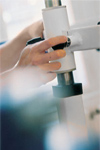|
Beside significantly weakened spinal muscles, patients with backpain also show a marked lack of coordination regarding their spine compared with painfree healthy subjects. A direct consequence of this is the marked reduction of reflectory skills - like the ability of our neuromuscular system to prevent a fall after stumbling.
The responsible muscular system comprises of the deep, short muscles, located nearest the vertebrae (e.g. mm. multifidii, mm. rotatorii,...) as well as the deepest stomache muscle, named m. transversus abdominis. The problem: these muscles can not be trained with conscious, classical muscletraining, because they are just activated in unexpected, reflextory situations like slipping on the ice or stumbling over an obstacle. For this sake the scientists from the U.S. Airforce and the NASA about 15 years ago developed a 3-ring-construction, where every ring represents one dimension and can be activated one after each other. This makes it possible, that one can be trained very simply and easily, increasing the complexity and intensity more and more, untill maximum force can be applied in 360°.
The NASA called the apparatus "Spacecurl" and trains astronauts with it still today. The Germans adapted the Spacecurl for medical use in the late 90ies, so that it came to medical institutions like paincare at 2000. We belonged to the first institutions worldwide to find out, how it worked in backpain patients and what longterm effects regarding painrelapse could be seen.
We always start with a thourough first investigation with Dr. Stengg. If the patient has no pain at this time, the next step is the exact musclestrength analysis and a special sensomotoric performance test to reveal, how weak the superficial muscles are and how the deep coordination system works. With these data we develop a 12-weeks training therapyplan together with you, where two units per week are sufficient, to bring 90% of the chronic backpain-patients out of their vitious circle. In most of the patients the strength in the big, superficial, spinal muscles is that poor that we have to start with building up a functioning musclecorset. In a second step we focus on the maintainance of the gained musclestrength on the one hand, but on the other hand focus with strong effort on reestablishing the coordinative abilities with the Spacecurl and other sensomotoric tools. |

 |

